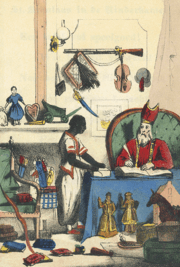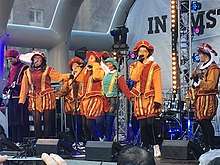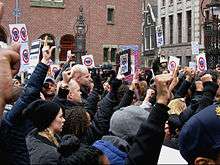Zwarte Piet
Zwarte Piet (pronounced [ˈzʋɑrtə ˈpit]; English: Black Pete or Black Peter, Luxembourgish: Schwaarze Péiter, Indonesian: Pit Hitam, West Frisian: Swarte Pyt, Afrikaans: Swart Pete) is the companion of Saint Nicholas (Dutch: Sinterklaas, Luxembourgish: Kleeschen, Indonesian: Sinterklas) in the folklore of the Low Countries. The character first appeared in an 1850 book by Amsterdam schoolteacher Jan Schenkman. Traditionally, Zwarte Piet is black because he is a Moor from Spain.[1] Those portraying Zwarte Piet usually put on blackface and colourful Renaissance attire in addition to curly wigs and bright red lipstick. In recent years, the character has become the subject of controversy.
_(2).jpg)
Traditions

The Zwarte Piet character is part of the annual Feast of St. Nicholas that is celebrated on the evening of 5 December (Sinterklaasavond, which is known as St. Nicholas' Eve in English) in the Netherlands, Aruba, and Curaçao. This is when presents and sweets are traditionally distributed to children. The holiday is celebrated on 6 December in Belgium.[2] The Zwarte Piet characters appear only in the weeks before the Feast of Saint Nicholas, first when the saint is welcomed with a parade as he arrives in the country (generally by boat, having traveled from Madrid, Spain). The tasks of the various Zwarte Piets (Zwarte Pieten in Dutch) are mostly to amuse children and to distribute kruidnoten, pepernoten, and other strooigoed (special Sinterklaas-themed sweets) to those who come to meet the saint as he visits schools, stores, and other places.
History
Origins
According to Hélène Adeline Guerber and other historians,[3][4] the origin of Sinterklaas and his helpers have been linked by some to the Wild Hunt of Odin. While riding the white horse Sleipnir, he flew through the air as the leader of the Wild Hunt. He was always accompanied by two black ravens, Huginn and Muninn.[5] These helpers would listen, just like Zwarte Piet, at the chimneys of the homes they visited to tell Odin about the good and bad behavior of the mortals below.[6][7]

The Saint Nicholas tradition contains a number of elements that are not ecclesiastical in origin.[8][9] In medieval iconography, Saint Nicholas is sometimes presented as taming a chained demon, who may or may not be black. However, no hint of a companion, demon, servant, or any other human or human-like fixed companion to the Saint is found in visual and textual sources from the Netherlands from the 16th until the 19th century.[10] According to a long-standing theory first proposed by Karl Meisen,[11] Zwarte Piet and his equivalents in Germanic Europe were originally presented as one or more enslaved demons forced to assist their captor. These chained and fire-scorched demons may have been redeveloped as black-skinned humans during the early 19th-century in the Netherlands in the likeness of Moors who work as servants for Saint Nicholas.[12]
One or more demons working as helpers for the saint can still be found in various Austrian, German, Swiss, Hungarian, Czech, Slovak, and Polish Saint Nicholas traditions in the characters of Krampus, Père Fouettard, Schmutzli, Perchta, Knecht Ruprecht, Rubbels, Hanstrapp, Little Babushka, Pelzebock, Klaubauf, and Belsnickel. These companions of Saint Nicholas are often depicted as a group of closely related figures who accompany Saint Nicholas through the territories formerly controlled by the Holy Roman Empire. The characters act as foils to the benevolent gift-giver, or strict disciplinarians who threaten to thrash or abduct disobedient children. Mythologist Jacob Grimm associated the character with the pre-Christian spirit kobold, who could be either benevolent or malicious.
The introduction of Zwarte Piet did coincide, by and large, with a change in the depiction of the Sinterklaas character. Prior to this change, he was often quite strict toward poorly behaved children and often presented as a sort of bogeyman.[9] Many of the terrifying characteristics that were later associated with Zwarte Piet were often attributed to him.[13] The presentation of a holy man in this light was troubling for both teachers and priests. After the introduction of Zwarte Piet as Sinterklaas' servant, both characters adopted more gentle personas.[14]
The lyrics of older traditional Sinterklaas songs, still sung today, warn that Sinterklaas and his assistant will leave well-behaved children presents but punish those who have been naughty. They might even take very poorly behaved children to their homeland of Spain in burlap sacks where, according to legend, they'll be forced to assist them in their workshop for an entire season or longer. These songs and stories also warn that a child who has been only slightly naughty will receive a bundle of birch twigs or a lump of coal instead of gifts.
Development and depiction in the 19th and 20th centuries
In 1850, the Amsterdam-based primary school teacher Jan Schenkman published the book Sint Nikolaas en zijn Knecht ("Saint Nicholas and his Servant" in English). It's widely considered the first time a servant character was included in a printed version of the Saint Nicholas narrative. The servant is depicted as a page who appears as a dark-skinned person wearing clothes associated with Moors. The book also established another mythos that would become standard: the intocht or "entry" ceremony of Saint Nicholas and his servant (then still nameless) involving a steamboat. Schenkman has the two characters arrive from Spain with no reference made to Nicholas' historical homeland of Myra (Lycia, which was located in what is now modern-day Turkey). In the 1850 version of Schenkman's book, the servant is depicted in simple white clothing with red hems. Beginning with the second edition in 1858, the page is illustrated in a much more colorful page costume.
The book remained in print until 1950 and has had considerable influence on the current celebration.[15] Although in Schenkman's book the servant was nameless, author Joseph Albert Alberdingk Thijm provided him with the name "Pieter-me-knecht" in a handwritten note to E.J. Potgieter in 1850.[16] In 1884, Alberdingk Thijm recalled that, when he was a child in 1828, he had attended a Saint Nicholas celebration in the house of Dominico Arata, an Italian merchant and consul living in Amsterdam. On this occasion, a man portraying Saint Nicholas had been accompanied by another described as "Pieter me Knecht ..., a frizzy haired Negro" who brought a large basket filled with presents.

In 1833, an Amsterdam-based magazine printed a humorous reference to "Pietermanknecht" while describing the fate that those who had sneaked out of their houses to attend that year's St. Nicholas celebrations were supposed to have endured after returning home.[17] In 1859, the Dutch newspaper De Tijd noticed that Saint Nicholas was often accompanied by "a Negro, who, under the name of Pieter, mijn knecht, is no less popular than the Holy Bishop himself".[18] In the 1891 book Het Feest van Sinterklaas, the servant is named Pieter. However, up until 1920, several additional publications gave the character other names and depictions that varied considerably.
According to a story from the Legenda Aurea, retold by Eelco Verwijs in his 1863 monograph Sinterklaas, one of the miraculous deeds performed by Saint Nicholas after his death consisted of freeing a boy from slavery at the court of the "Emperor of Babylon" and delivering him back to his parents.[19] No mention is made of the boy's skin color. However, over the course of the 20th century, narratives started to surface that claimed Zwarte Piet was a former slave who had been freed by the saint and had subsequently become his lifelong companion.[20]
According to another popular explanation that came to prominence in the later decades of the 20th century, Zwarte Piet is a Spanish or Italian chimney sweep whose blackness is due to a permanent layer of soot on his body acquired during his many trips down the chimneys of the homes he visits.[9]
Development and depiction in the 21st century

Because of ongoing controversies surrounding the character, many schools, businesses, and other organizations across the Netherlands have begun changing Zwarte Piet's clothing and makeup or phasing the character out entirely. The most common variation has been dubbed ‘Sooty Pete’ (in Dutch: roetveegpiet). This version features the page outfit but without the curly wig, earrings, or lipstick. Smeared on makeup simulates soot smudges and an actor portraying the character retains their own natural skin tone.
In 2015, the Bijenkorf department store chain opted to replace holiday displays featuring Zwarte Piet with a golden-skinned version instead.[21] Elsewhere, one in three Dutch primary schools announced plans to alter the character's appearance in their celebrations.[22] Nickelodeon in the Netherlands also decided to use a racially mixed group of actors to portray Piet in their holiday broadcasts instead of people in blackface.[23] RTL Nederland made a similar decision in the autumn of 2016 and replaced the characters with actors with soot on their faces.[24]
However, in 2018, several members of a production crew refused to work on Dutch broadcaster NTR's nationally televised celebration because of a decision to alter the character.[25] Several Dutch entertainers have also continued to use the traditional version of the character. Among them are the singers Leon Krijgsman and Herman van Doorn who released songs promoted with music videos featuring Piets in blackface.[26]
Notable events during the 21st century
Throughout the latter half of the 2010s, communities and various organizations across the Netherlands and elsewhere opted to use either the traditional version of Zwarte Piet in celebrations or variations, most commonly the Sooty Pete version.[27] Some have included both. These decisions have resulted in protests and violent incidents involving pro-Piet demonstrators (those who endorse the traditional version of the character) and anti-Piet demonstrators (those who endorse a revised version of the character or doing away with him altogether).[28]
In November of 2017, a group of anti-Piet demonstrators were prevented from attending a demonstration during a nationally-televised celebration in the town of Dokkum after their vehicles were blocked on the A7 motorway by pro-Piet demonstrators, 34 of whom were later charged and found guilty of obstructing traffic.[29] During intocht celebrations throughout November of 2018, violent incidents took place in the cities and towns of Nijmegen, The Hague, Leeuwarden, Den Helder, Rotterdam, and elsewhere. In Eindhoven, anti-Piet demonstrators were surrounded by an estimated group of 250 people described as "football hooligans" who attacked them with eggs and shouted racist insults. A similar protest in Tilburg led to the arrest of 44 pro-Piet demonstrators.[30]
In 2019, it was decided that the nationally-televised arrival of Sinterklaas hosted by Apeldoorn would feature only Sooty Petes.[31] That November, a group called Kick Out Zwarte Piet were attacked during a meeting. Windows were smashed, nearby vehicles were vandalized, and fireworks were shot into the building where the group was planning protests in 12 communities that still feature traditional versions of the character.[32]
Public opinion in the Low Countries and worldwide
Due to the character's depiction, which often involves actors and volunteers dressing up in blackface while wearing black wigs and large earrings, the traditions surrounding Zwarte Piet became increasingly controversial beginning in the late 20th century.[33] As of the early 2010s, a large majority of the overall populace in both the Netherlands and Belgium was in favor of retaining the traditional Zwarte Piet character.[34][35][36][37] Studies have shown that the perception of Zwarte Piet can differ greatly among different ethnic backgrounds, age groups and regions.[38]
Outside of the Netherlands, the character has received criticism from a wide variety of international publications and news organizations.[39] Among others, American essayist David Sedaris has written about the tradition,[40] and British comedian and activist Russell Brand has spoken negatively of it, the latter dubbing Zwarte Piet "a colonial hangover."[41] In 2019, media personality Kim Kardashian described Zwarte Piet as "disturbing" in a tweet to her over 62 million followers on Twitter.[42]
Nevertheless, according to a 2013 survey, upward of 90 per cent of the Dutch public do not perceive Zwarte Piet to be a racist character or associate him with slavery and are opposed to altering the character's appearance.[43] This correlates to a 2015 study among Dutch children aged 3 to 7 which showed that they perceive Zwarte Piet to be a fantastical clownish figure rather than a black person.[44] However, the number of Dutch people who are willing to change certain details of the character (for example his lips and hair) is reported to be growing.[45][46] By 2018, studies showed that between 80 and 88 per cent of the Dutch public did not perceive Zwarte Piet as racist, and between 41 and 54 per cent were happy with the character's modernized Sooty Pete style.[47][48]


Opposition to the figure is mostly found in the most urbanized provinces of North and South Holland, where between nine and seven per cent of the populace wants to change the appearance of Zwarte Piet. In 2012 in Amsterdam, most opposition toward the character was found among the Ghanaian, Antillean and Dutch-Surinamese communities, with 50 per cent of the Surinamese considering the figure to be discriminatory to others, whereas 27 per cent consider the figure to be discriminatory toward themselves.[49] The predominance of the Dutch black community among those who oppose the Zwarte Piet character is also visible among the main anti-Zwarte Piet movements, Zwarte Piet Niet and Zwarte Piet is Racisme which have established themselves since the 2010s. Generally, adherents of these groups consider Zwarte Piet to be part of the Dutch colonial heritage, in which black people were subservient to whites or are opposed to what they consider stereotypical black ("Black Sambo") features of the figure including the red lips, curly hair and large golden earrings.[50]
The public debate surrounding the figure can be described as polarized, with some protesters considering the figure to be an insult to their ancestry and supporters considering the character to be an inseparable part of their cultural heritage.[45]
See also
- Border Morris – A collection of individual local dances from Herefordshire, Worcestershire and Shropshire
- Ded Moroz – Fictional Christmas character in eastern Slavic cultures
- Hajji Firuz – Character in Iranian folklore who appears in the streets by the beginning of Nowruz
- Knecht Ruprecht
- Krampus – horned, anthropomorphic folklore figure associated with Christmas
- Santa Claus – Mythical character, said to deliver gifts to children on Christmas Eve
- Siuda Baba – An old Polish folk custom, celebrated on Easter Monday
- Snegurochka
References
- Forbes, Bruce David (2007). Christmas: A Candid History. University of California Press.
- "Sinterklaas traditions in the Netherlands".
- Door Ernie Ramaker (3 December 2011). "Wat heeft Sinterklaas met Germaanse mythologie te maken?" (in Dutch). Historianet.nl. Retrieved 18 November 2013.
- "American Christmas Origins". Arthuriana.co.uk. Retrieved 18 November 2013.
- Hélène Adeline Guerber (d. 1929). "huginn and muninn "Myths of the Norsemen" from". gutenberg.org. Retrieved 26 November 2012.
- Booy, Frits (2003). "Lezing met dia's over 'op zoek naar zwarte piet' (in search of Zwarte Piet)" (in Dutch). Retrieved 29 November 2007. Almekinders, Jaap (2005). "Wodan en de oorsprong van het Sinterklaasfeest (Wodan and the origin of Saint Nicolas' festivity)" (in Dutch). Archived from the original on 26 April 2012. Retrieved 28 November 2011. Christina, Carlijn (2006). "St. Nicolas and the tradition of celebrating his birthday". Retrieved 28 November 2011.
- "Artikel: sinterklaas and Germanic mythology" (in Dutch). historianet.nl. 3 December 2011. Retrieved 8 December 2012.
- "Piet en Sint - veelgestelde vragen". Meertens Instituut. Retrieved 19 November 2013.
- "Sinterklaas rituelen en tradities". jefdejager.nl. Retrieved 19 November 2013.
- E. Boer-Dirks, "Nieuw licht op Zwarte Piet. Een kunsthistorisch antwoord op de vraag naar de herkomst", Volkskundig Bulletin, 19 (1993), pp. 1-35; 2-4, 10, 14.
- In Nikolauskult und Nikolausbrauch im Abendlande: Eine kultgeographisch-volkskundliche Untersuchung (Düsseldorf, 1931).
- "Jan Schenkman" (in Dutch). dbnl.nl. Retrieved 28 November 2010.
- For example: J. ter Gouw, in De volksvermaken (Haarlem, 1871), p. 256, describes an ancient tradition of "Zwarte Klazen" in Amsterdam; A.B. van Meerten, in Reisje door het Koningrijk der Nederlanden en het Groot-Hertogdom Luxemburg, voor kinderen (Amsterdam, 1827), describes a (fictional?) St. Nicholas celebration in which the Saint appears "with a black face ... with a whip and a rod in his hands"; and in De Nederlandsche Kindervriend, in gedichtjes voor de welopgevoede jeugd (Amsterdam, 1829), pp. 72-74, "Sinterklaas" is referred to as "a black man" who was said to descend down the chimney "with a great noise of chains" which he used for fettering naughty children. Respondents to a 1943 survey of the Meertens Instituut wrote that they had known Saint Nicholas "as a bishop or as a black man with a chain on his foot" and "in the shape of a black man. The bishop was unknown in my youth" (J. Helsloot, "Sich verkleiden in der niederländischen Festkultur. Der Fall des 'Zwarte Piet'", Rheinisches Jahrbuch für Volkskunde 26 (2005/2006), pp. 137-153; 141).
- Booy, Frits (2003). "Lezing met dia's over 'op zoek naar zwarte piet' (in search of Zwarte Piet)" (in Dutch). Retrieved 29 November 2007.
- ""St Nicholas en zijn knecht" by Jan Schenkman". Librivox.org. 12 October 2010. Retrieved 26 November 2012.
- van Duinkerken, A. (5 December 1931). "Sint Niklaasgoed 1850 (Een surprise van Thijm aan Potgieter)". De Tijd. pp. 21–22.
- "Zij echter, die ter sluik op het St. Nicolaas feest hadden rondgewandeld, vonden, te huis komende, de Pietermanknecht te hunnent; de zoons in hunne vaders, de mannen in hunnen vrouwen en de dienstmeisjes in hunne gebiedsters." ("St. Nikolaas", De Arke Noach's, 7, 10 (December 1833), pp. 294-299; p. 296)
- Helsloot, J. (November 2011). "De oudst bekende naam van Zwarte Piet: Pieter-mê-knecht (1850)". Digitale nieuwsbrief Meertens Instituut.
- Eelco Verwijs, Sinterklaas (The Hague: Martinus Nijhoff, 1863), p. 13. The slave is a young Alexandrian named Adeodatus.
- See, for instance, the story of the Ethiopian slave "Piter" in Anton van Duinkerken, "De Geschiedenis van Sinterklaas", De Tijd, 21 November 1947, p. 3; "Sint Nicolaas bevrijdde een slaaf. Uit dankbaarheid ging deze vrijwillig de Sint dienen; hij heet Zwarte Piet", De Nieuwsgier, 3 December 1954, p. 3; and also, from a slightly different angle, Puck Volmer, "Hoe Zwarte Piet het knechtje van Sinterklaas werd", De Indische Courant, 29 November 1941, p. 19.
- "Zwarte Pieten in Bijenkorf worden goud". RTL. 10 August 2015. Retrieved 3 December 2015.
- "Hema Reportedly Phasing Out Zwarte Piet". DutchNews. 26 August 2014. Retrieved 2 September 2014.
- "Nickelodeon presenteert ongeschminkte pieten". NRC. 4 November 2015. Retrieved 3 December 2015.
- "RTL stopt met Zwarte Piet, voortaan alleen pieten met roetvegen". RTL. 24 October 2016. Retrieved 25 October 2016.
- "Sintcomite Zaanstad trekt zich terug uit intocht". De Telegraaf. 4 October 2018. Retrieved 10 July 2019.
- "1 Miljoen Schoenen". YouTube. 4 November 2018. Retrieved 10 July 2019.
- "Zwarte pieten willen niet meer". NRC. 7 November 2019. Retrieved 15 November 2019.
- "Door de ervaringen in Friesland denken voorstanders van Zwarte Piet dat dreigen met geweld loont". Volkskrant. 18 November 2018. Retrieved 15 November 2019.
- "A7-blokkeerders wilden anti-Zwarte Piet-betogers 'alleen vertragen'". AD. 9 October 2018. Retrieved 15 November 2019.
- "Amnesty International, MPs call on PM to condemn pro-Piet violence". DutchNews. 19 November 2018. Retrieved 15 November 2019.
- "Netherlands Christmas parade to replace blackface make-up with soot". The Irish Times. 18 September 2018. Retrieved 15 November 2019.
- "Zwarte Piet protest group accuses police of failing to protect safety". DutchNews. 11 November 2019. Retrieved 15 November 2019.
- Blakely, Allison (2001). Blacks in the Dutch World: The Evolution of Racial Imagery in a Modern Society. Indiana University Press. pp. 48–49. ISBN 9780253214331.
- "Onderzoek RTL Nieuws: Zwarte Piet moet zwart blijven". RTL Nieuws. Retrieved 6 December 2015.
- In a poll of RTL Nieuws, 81 per cent only supported a solely black Zwarte Piet with an additional 10 per cent supporting a majority of Zwarte Piets with a few soot-covered ones.
- A 2015 research project conducted by the national newspaper Algemeen Dagblad showed that in the overwhelming majority of Dutch municipalities no changes would be made to the traditional appearance of the Zwarte Piet character. Only 6 per cent of the municipalities approached mentioned (further unspecified) changes to the character.
- A 2013 inquiry by Dutch public news program EenVandaag showed that in every Dutch province, the overwhelming majority did not support changes in the Zwarte Piet characters appearance. The largest percentage in support of changing the character's appearance (nine per cent) was found in North-Holland.
- "In a 2012 study by the municipality of Amsterdam, shows that majority of respondents do not consider the Zwarte Piet character to be racist or that the character is racists toward others, but this differs greatly when comparing ethnic groups" (PDF). Ois.amsterdam.nl. Retrieved 14 January 2019.
- Felicity Morse. "Zwarte Piet: Opposition Grows To 'Racist Black Pete' Dutch Tradition". UK: Huffington Post. Retrieved 27 October 2012.
- "Don't They Know It's Christmas After All". This American Life. Retrieved 7 December 2001.
- "Russel Brand Over Zwarte Piet". De Morgen. Retrieved 17 November 2014.
- "Wat betekent de tweet van Kim Kardashian voor het imago van Nederland?". RTL Nieuws. Retrieved 21 November 2014.
- "VN wil einde Sinterklaasfeest - Binnenland | Het laatste nieuws uit Nederland leest u op Telegraaf.nl [binnenland]". Telegraaf.nl. 22 October 2013. Retrieved 19 December 2013.
- 2015 enquiry shows children perceive Zwarte Piet as a clown rather than black. NRC Handelsblad 3 December 2015.
- "Cookies op Trouw.nl". trouw.nl. Retrieved 6 December 2015.
- "Black Pete: Cheese-Face to Partially Replace Blackface During Dutch Festivities". The Independent. 15 October 2014. Retrieved 12 December 2014.
- "Onderzoek: Zwarte Piet is genoeg aangepast". Een Vandaag. 16 November 2018. Retrieved 30 November 2018.
- "Onderzoek: Rapportage Zwarte Piet" (PDF). Een Vandaag. 15 November 2018. Retrieved 18 February 2019.
- "Hoe denken Amsterdammers over Zwarte Piet?" [What do Amsterdammers think about Zwarte Piet?] (PDF) (in Dutch). 2013. Retrieved 29 November 2018.
- "De argumenten voor Zwarte Piet zijn op". HP/De Tijd. Retrieved 6 December 2015.
External links
| Wikimedia Commons has media related to Zwarte Piet. |